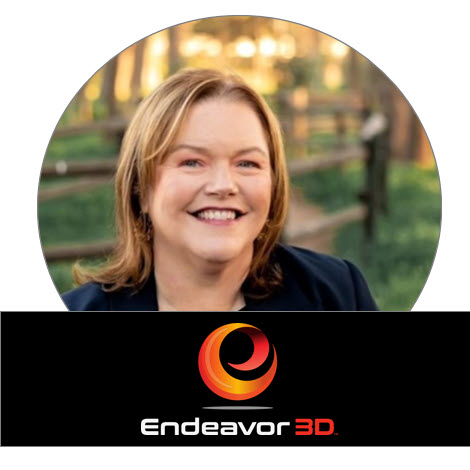
The beauty of today’s manufacturing environment is that anyone can start a 3D printing service bureau and begin printing parts today. According to a recent report by Persistence Markets, the 3D printing service bureau industry is projected to surge eight times the size of its present state over the next decade. Forget the lemonade stand, today’s industrious children are downloading CAD drawings from the internet, printing figurines and selling them amongst their classmates. Although the stakes may be a little higher in the commercial world, the formula is no different. There are several key considerations when starting your own service bureau and this article will include insights from several veterans and newcomers.
- Janet Dickinson, Chief Revenue & Information Officer, Endeavor 3D
- Scott Volk, President, Advanced Additive Innovations, Inc.
- Zac Holcomb, CEO & Founder, Additive America
Understand Yourself & Your Audience
Similar to the entrepreneurial child in the classroom, who sees a target-rich environment interested in customized toys, you too must know your audience. But before that, what capabilities do you (or your organization) bring to the table? Do you possess engineering knowledge and design capabilities? Does your business already offer other contract manufacturing services? Have you spent your career in a production facility and know the challenges assembly line workers face every day? Leverage the strengths of your organization and combine them with your own personal/professional skill sets to get a better idea of what you bring to the table. If you’re starting your own service bureau, then be prepared that this is not a conventional 9 to 5 job.
By knowing your own strengths and weaknesses, you can establish your value proposition thesis and research the target audience. Begin with your own network and start identifying potential customers. Reach out to those contacts and do everything you can to learn about their knowledge of 3D printing, typical lead times for part services, in-house fabrication capabilities and make a list of common challenges they are experiencing. Refine your value prop for these potential customers and identify differentiators.
Scott Volk, President at Advanced Additive Innovations, Inc., has over two decades of experience working in 3D printing and currently runs his own shop in Mooresville, North Carolina. Volk commented, “‘The old saying is ‘time, cost and quality – pick two.’ Historically, that’s been the baseline to provide a competitive advantage in engineering services but I want to add one more, customer service. Customer acquisition is more costly than customer retention, it is paramount to always put the customer first and do everything you can to solve their problems and keep them happy. There are a lot of service providers out there, never underestimate customer loyalty or you’ll be paying for it on the back end.”
Determine Technologies + Materials That Fit Within Your Addressable Market
After a thorough investigation of your target audience, the next step is to determine which additive technologies and materials will best solve their challenges. There are countless polymer-and metal-3D printing products available on the market, represented by a complex matrix of technologies and materials which places a great emphasis on due diligence. Furthermore, the difference between consumer and professional grade equipment is a lot of money, I can’t stress it enough, know your audience.
It’s important to determine if your business model is to engage in one-off projects for customers or expand to volume production offerings. Most service bureaus lean towards production volume but there is an opportunity for both to succeed. In addition, have a clear understanding of polymer or metal capabilities and how much the consumables are going to cost. Build your business model and test the pricing details with your target customer.
Many 3D printing OEMs have well-established service bureau businesses or partners, I recommend researching not only the technology but the business as a whole. What are the technology reviews? Which company has been the most supportive of its partners? Try to learn as much about each company, and look for a partner, not just a provider.
Endeavor 3D, a service bureau located in Douglasville, Georgia, opened its doors in 2020 and went through a similar exercise when evaluating technologies. Janet Dickinson, Chief Revenue Officer, had this to say, “I’m not originally from this industry but when you look at all the user groups and networks, it’s obvious that collaboration is the right path towards collective success. Equipment manufacturers, material suppliers, and service providers are all searching for ways to improve the bottom line. Our strategy is to develop valuable partnerships with our selected OEMs that are mutually beneficial. We give just as much as we take.”

If you are in the technology investigation stage then I highly recommend establishing a list of user groups or communities that provide this sort of honest feedback on products, materials and partners. For example, UltiMaker has a great online community forum and the Additive Manufacturing Users Group has become the leading source of information and networking in North America.
Build Your Presence
Now that you’ve selected the right technologies and established a business model that will solve problems for your customer, it’s time to build your presence. As a marketer, I highly recommend building your website and establishing your presence on LinkedIn platforms. In today’s environment, these are the most valuable branding and lead generation tools available, do not underestimate them. It may seem overwhelming at first but trust me, it’s essential. Start small, implement self-imposed deadlines and get your website live and start networking on LinkedIn. Depending on how sophisticated you want your website to be, I recommend Squarespace or Wix for novice website builders. An alternative that I would consider is Hubspot, which integrates website, email marketing and CRM systems together in one location.
When it comes to LinkedIn, no one has mastered this platform better than Zac Holcomb, CEO and Founder of Additive America. Holcomb has over 22,000 followers and has gained notoriety for his authentic and honest approach. “It takes me five minutes to create video content and it could get 10,000+ views. Instead of the polished marketing materials, I think people gravitate to my stuff because I’m constantly learning, providing information in a non-traditional sense, and sharing that journey honestly. People get tired of being sold, especially engineers, so don’t forget to be human. Selling from receiving a call is so much easier than cold calling so you cannot underestimate building your presence.”

Next, it’s important to understand that the service bureau industry is highly competitive and that battleground is typically fought on Google search. (If you’re interested to see how competitive the market it, I recommend taking a look at Additive Manufacturing Media’s North America Service Bureau Map recently updated in 2021). The goal is to get on the first page of search results. Use your value proposition and identify the keywords that will work for you. For example, if your service bureau is an engineering design powerhouse or is capable of printing certain materials then consider, ”additive design services,“ or, “carbon fiber print services.”
Once you have established your top 5-10 keywords then you need to drive a content strategy for your website. Getting higher on the search results is dependent on the amount of relevant content that includes those keywords. The goal is to create informative material that is shared and used on other platforms — ultimately boosting awareness and web connectivity. As your business progresses, I recommend purchasing Google Ads for your target keywords which will automatically place you on the first page (for a fee of course). I recommend being very specific and targeted in this approach, otherwise “3D printing service bureau,” will get expensive competing with other well-established businesses that commit big dollars to this.

Hit the Pavement, Start Selling
The additive industry continues to expand with clear signs of adoption and so does the need for on-demand print services. According to the Jabil 2021 survey, 80-percent of manufacturers report using additive manufacturing to produce 25-50-percent of their functional or end-use parts. 44-percent of those currently outsource production to a service bureau. Much of this is due to their reluctance to invest in their own systems or lack of additive knowledge. The opportunity is growing, especially for those who can offer engineering and design services. Where to begin? Here are some recommendations:
- Lean on your equipment supplier(s) for co-marketing activities. Leverage your expertise or value propositions to become a steady and recognizable face on their platforms. Participate in a case study, offer up collaborative ideas, and keep an open line of communication.
- Sell engineering services for a fee. Oftentimes, your workshop or service bureau will receive incomplete files or ones that need adjustment to meet your technology offering. This is an ongoing battle in additive manufacturing, thus charging for DfAM (design for additive manufacturing) is common and accepted.
- Consider a short-term, loss-leader approach to attract potential high-value customers. Offer an aggressive, low-cost option that gets you a foot in the door. This is a very competitive market but money talks,once you get that customer, keep them at all costs.
- Underpromise and overdeliver. Specifically when it comes to timelines, do not commit to unreasonable expectations. If your client has to cancel a product design meeting or delay the next batch of production orders because you over-committed then say goodbye. Lead with empathy, understand your capacity, and aim to be a partner.
It’s easy to sell something until you actually have to do it. While this list of recommendations is rather general, my intent is that it provides some guidance and a few resources to help. Ultimately, you need to put together a strategy that works for your business model and consider creative approaches to beat the competition and keep the customer happy.
Parting Words of Wisdom
Let me conclude by stating, I’m NOT the authority on 3D printing. However, I’ve been in the industry since 2010 in a variety of sales or marketing roles, so I’ve seen a few things. Technology has moved fast in the last decade+ and there are countless new companies and products entering the market. Be diligent during the technology investigation stage because many of these new entrants are still trying to figure it out and the last thing you need is a paperweight collecting dust. Furthermore, don’t ride the hype train because it will lead to inflated expectations. Additive adoption is up, but it will never replace all injection molding, thus be realistic when drafting the next investor presentation. Finally, whether you are a one-person shop working in a garage or a team of engineers in a 65,000-square-foot manufacturing facility, always put people first. This is a growing, well-connected industry, so take care of each other.


